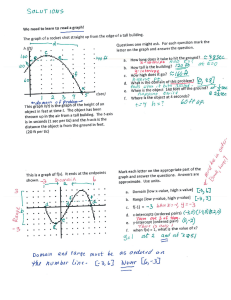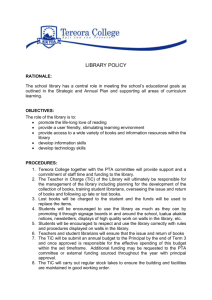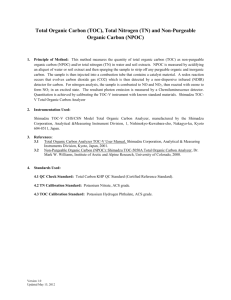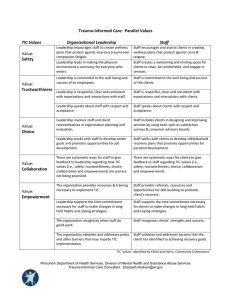HACH BioTector 3500c ANALYZER FOR TOC, TC, TIC and VOC
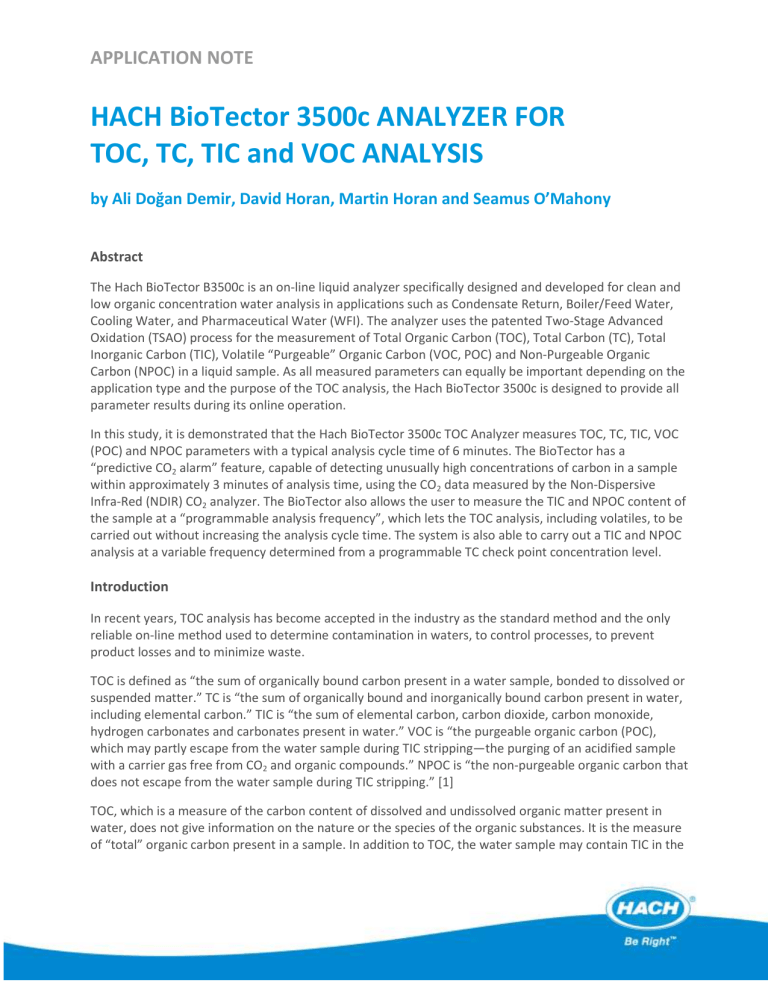
APPLICATION NOTE
HACH BioTector 3500c ANALYZER FOR
TOC, TC, TIC and VOC ANALYSIS
by Ali Doğan Demir, David Horan, Martin Horan and Seamus O’Mahony
Abstract
The Hach BioTector B3500c is an on-line liquid analyzer specifically designed and developed for clean and low organic concentration water analysis in applications such as Condensate Return, Boiler/Feed Water,
Cooling Water, and Pharmaceutical Water (WFI). The analyzer uses the patented Two-Stage Advanced
Oxidation (TSAO) process for the measurement of Total Organic Carbon (TOC), Total Carbon (TC), Total
Inorganic Carbon (TIC), Volatile “Purgeable” Organic Carbon (VOC, POC) and Non-Purgeable Organic
Carbon (NPOC) in a liquid sample. As all measured parameters can equally be important depending on the application type and the purpose of the TOC analysis, the Hach BioTector 3500c is designed to provide all parameter results during its online operation.
In this study, it is demonstrated that the Hach BioTector 3500c TOC Analyzer measures TOC, TC, TIC, VOC
(POC) and NPOC parameters with a typical analysis cycle time of 6 minutes. The BioTector has a
“predictive CO
2
alarm” feature, capable of detecting unusually high concentrations of carbon in a sample within approximately 3 minutes of analysis time, using the CO
2
data measured by the Non-Dispersive
Infra-Red (NDIR) CO
2
analyzer. The BioTector also allows the user to measure the TIC and NPOC content of the sample at a “programmable analysis frequency”, which lets the TOC analysis, including volatiles, to be carried out without increasing the analysis cycle time. The system is also able to carry out a TIC and NPOC analysis at a variable frequency determined from a programmable TC check point concentration level.
Introduction
In recent years, TOC analysis has become accepted in the industry as the standard method and the only reliable on-line method used to determine contamination in waters, to control processes, to prevent product losses and to minimize waste.
TOC is defined as “the sum of organically bound carbon present in a water sample, bonded to dissolved or suspended matter.” TC is “the sum of organically bound and inorganically bound carbon present in water, including elemental carbon.” TIC is “the sum of elemental carbon, carbon dioxide, carbon monoxide, hydrogen carbonates and carbonates present in water.” VOC is “the purgeable organic carbon (POC), which may partly escape from the water sample during TIC stripping—the purging of an acidified sample with a carrier gas free from CO
2
and organic compounds.” NPOC is “the non-purgeable organic carbon that does not escape from the water sample during TIC stripping.” [1]
TOC, which is a measure of the carbon content of dissolved and undissolved organic matter present in water, does not give information on the nature or the species of the organic substances. It is the measure of “total” organic carbon present in a sample. In addition to TOC, the water sample may contain TIC in the
form of carbon dioxide or ions of carbonic acid. Therefore, prior to the TOC determination, it is essential that the TIC is removed by acidifying and purging the sample with a carrier gas such as oxygen. This process is generally referred as “TIC stripping” or “TIC sparging”. Purgeable organic substances such as benzene, toluene, cyclohexane, chloroform, etc. may partly escape upon TIC stripping. In the presence of such volatile substances, the TOC concentration is determined by the differential method, where TOC = TC-TIC.
In other words, both TC and TIC are measured, and the TOC is calculated by subtracting the TIC from the
TC. This method is particularly suitable for samples in which the TIC is less than the TOC. When using the differential method, the value of the TOC should be higher than the TIC, or at least of similar size. [1, 2]
In addition to TOC, TIC is also an important parameter that needs to be monitored in applications such as condensate return water, boiler/feed water, etc. In boiler/feed water and in industrial steam generating systems, carbonic acid corrosion of condensate lines is often a serious problem. This is due to the formation of carbon dioxide in the boiler. Carbon dioxide carries over with the steam and then re-dissolves in condensate return lines. Carbonic acid is a solution of carbon dioxide in water, also called “carbonated water”. Carbonic acid forms two kinds of salts, the carbonates and the bicarbonates, in water. The absorption of carbon dioxide into the condensate drives the pH downward and the resultant acidic solution attacks the boiler and boiler pipe walls via the formation of ferrous bicarbonates Fe(HCO
3
)
2
. [3]
In earth’s hydrological cycle, water begins to evaporate as the sun heats up a body of water. The evaporated water gathers in the atmosphere and forms into clouds. When the water vapor in the clouds cools sufficiently to condense, it begins to rain. The rain is without impurities as it begins to fall, because it is pure and has a pH of pH 7; it is called “hungry rain,” with a high affinity for oxygen and carbon dioxide in the atmosphere. The rain droplets absorb the oxygen and carbon dioxide as they pass through the atmosphere. Some sources of carbon dioxide in the atmosphere are the result of combustion of fossil fuels, fermentation, respiration, etc. The carbon dioxide contributes to making the rain acidic (acid rain), and is the major source of carbon dioxide found in the boiler’s condensate return systems. As the rain enters the ground, the acid condition helps the water dissolve limestone and pick up other dissolved and suspended solids. These underground minerals, found in the boiler/feed water, are the source of boiler scale.
A steam boiler’s hydrological cycle is similar to that of the earth’s hydrological cycle. In a steam boiler system there are three potentially destructive elements: oxygen, carbon dioxide, and solids. As the boiler water is heated and changes to steam, free oxygen is released, carbon dioxide is released from the solids, and the solids precipitate. As the steam is used, it cools and turns to condensate in the steam system. The condensate, like the rain droplets, is “hungry condensate” with a high affinity for carbon dioxide and oxygen. As the condensate cools, it becomes easier for gases like carbon dioxide and oxygen to dissolve in the water. Carbon dioxide is absorbed by the cooling condensate causing it to become acidic, creating a condition similar to “acid rain” found in the earth’s hydrological cycle. The acidic condition erodes iron pipes, creating a trench in the bottom of condensate piping and sometimes eroding all the way through the pipe.
Raw water, as received through the city mains or wells, contains impurities, including carbon dioxide. As condensate cools, it becomes easier for the carbon dioxide gas to dissolve in the water. Carbon dioxide combined with water can form carbonic acid with a pH range from 6.9 to approximately pH 4.4. This acidic condition occurs in steam condensate piping systems, and if the piping is carbon steel, it is likely that the pipe will be damaged. This damage can be general, overall corrosion, localized pitting or cracking in stressed metal. [4]
Cooling water monitoring generally describes the characterization of volatile organic pollutants that are capable of entering a water matrix. While generic or indicator monitoring may be required to identify the existence of volatile organic compounds, speciated compound characterizations may also be required in
some instances to characterize the specific compounds present in the cooling water. [5] Heat exchangers are used to remove heat from a process stream. The process stream is cooled by using, for instance, river water in a cooling tower. One of the common issues with the heat exchangers is “break-through” when the seals or tubes of the heat exchanger fail and permit the process and cooling water to mix. Problems that can be created by this type of failure include release of organic and volatile organic carbon compounds and cooling tower contamination.
These facts illustrate the importance of TOC, TC, TIC and VOC measurement in condensate return, boiler/feed water and cooling water applications. Depending on the application type, analysis of only one parameter (e.g., TC) is generally not sufficient to make any useful process decisions. Multiple-parameter analysis (TOC, TC, TIC, VOC etc.), as carried out in the Hach BioTector B3500c analyzer, is proven to be more useful and always superior to single-parameter analysis in the industry.
Analysis Types and Operation
The Hach BioTector B3500c analyzer can be configured as:
1.
A TIC & TOC (NPOC) system to measure the Total Inorganic Carbon (TIC) and Total Organic Carbon
(TOC) content of a liquid sample. The TOC result obtained from a TIC & TOC system represents the
Non-Purgeable Organic Carbon (NPOC) because VOC (POC) compounds may partly escape from the sample during TIC stripping. The TIC & TOC system is suitable for samples that contain very low or insignificant concentrations of volatile organic materials.
2.
A TC system to measure the Total Carbon (TC) content of a sample. The TC result obtained from a TC system represents the sum of TIC, NPOC and VOC content.
3.
A VOC system to measure the TIC, TOC, TC and VOC contents of a sample. The TOC result in a VOC system is calculated from the TC and TIC measurements as TOC = TC - TIC. Therefore, the TOC result includes the volatiles present in the sample. In other words, the TOC result represents the sum of
NPOC and VOC (POC) content.
The operation of a BioTector configured as a TIC & TOC (NPOC) system can be summarized as follows:
1.
A representative, unfiltered liquid sample is brought to the analyzer by means of a peristaltic pump.
An accurate amount of sample is injected into the reactor chamber.
2.
The sample’s inorganic carbon content is sparged by the addition of an acid reagent (typically sulfuric acid). The released carbon dioxide (CO
2
) gas is transferred by oxygen (O
2
) carrier gas and is measured as Total Inorganic Carbon (TIC) in a non-dispersive infrared (NDIR) CO
2
analyzer. This stage is called the
“TIC” phase.
3.
A high-pH reagent (typically sodium hydroxide) is added into the reactor and the ozone generator is switched on. Hydroxyl radicals (OH•) are formed in the presence of high pH reagent and ozone. The effective and complete oxidation of the sample fluid takes place in the presence of excess hydroxyl radicals. This stage, which is called the “Base Oxidation” phase, forms the first stage of the TSAO process. During the base oxidation phase, all organic content is oxidized to carbonates (the major product) and oxalates (the minor product).
4.
The acid reagent, which contains a catalyst, is added into the reactor. The ozone generator is switched on. In an acidic environment, the minor product, oxalates, are oxidized and sparged in the form of CO
2 gas. The major product, carbonates, are also sparged in the form of CO
2
gas. This stage is called the
“TOC Oxidation” phase; it forms the second and final stage of the TSAO process. The sparged CO
2
gas is measured by the non-dispersive infrared (NDIR) CO
2 analyzer. The measured TOC result represents the sample’s Non-Purgeable Organic Carbon (NPOC) element.
Using a BioTector configured as a TC system, the TIC phase described above is not carried out. Because the
TIC stripping does not take place during TC analysis, no volatile organic material escapes from the sample.
Therefore, when the oxidation process is completed, the measured Total Carbon (TC) result represents the sum of TIC, NPOC and POC. TC = TIC + NPOC + POC
Using a BioTector configured as a VOC system, a combination of TC analysis and TIC & TOC (NPOC) analysis is carried out. The VOC result obtained represents the Purgeable Organic Carbon (POC) content of the sample. When the TC and TIC & TOC (NPOC) analysis are complete, the following data is available:
TC result, as measured by the TC analysis.
TIC result, as measured by the TIC & TOC (NPOC) analysis.
TOC result including the volatiles (TOCv), calculated from the difference between the TC and TIC measurements as follows: TOCv = TC – TIC
The TOC result in VOC analysis represents the sum of NPOC and POC: TOCv = NPOC + POC
VOC (POC) result, calculated from the difference between the measured TC (from the TC analysis), and the sum of measured TIC and measured NPOC (from the TIC & TOC “NPOC” analysis):
VOC = TC – (TIC + NPOC)
With a Hach BioTector B3500c analyzer configured as a VOC system, it is possible to program the analyzer to carry out the TIC & TOC (NPOC) analysis at a preferred analysis frequency. This means that the unit can be programmed by the user to continuously carry out the TC analysis in a 6-minute cycle and carry out TIC
& TOC (NPOC) analysis, which also takes approximately 6 minutes, at a designated frequency so that all
TC, TIC, TOCv and VOC parameter results are available. For instance, when the frequency of the TIC & TOC
(NPOC) analysis is programmed as 10, it carries out the TC analysis every 6 minutes cycle as normal, and carries out the TIC & TOC (NPOC) analysis every 10th analysis cycle, or approximately every 60 minutes in this example.
With a Hach BioTector B3500c analyzer configured as a VOC system, it is also possible to program a TC concentration level that would act as an automatic check point, where the analyzer carries out a TIC &
TOC (NPOC) analysis in addition to the TC analysis. In the event of a high TC result, this operation with the automatic check point helps identify whether the increase in the TC result is coming from the TIC and/or the TOCv content. For instance, assume that the TC concentration check point is programmed as 4mgC/L
(4ppm TC) in the analyzer. If the measured TC result exceeds 4mgC/L, the analyzer immediately runs a TIC
& TOC (NPOC) analysis on the same sample regardless of the programmed TIC & TOC (NPOC) analysis frequency described above. This means that it carries out TIC & TOC (NPOC) analysis cycle at a variable frequency depending on the programmed “automatic check point” TC concentration level. This operation allows the user to determine whether the increase in the TC result is due to an increase in TIC or due to an increase in TOCv concentrations.
The BioTector VOC system operation described above gives the benefit of obtaining TC results within a short period of time without carrying out any unnecessary TIC & TOC (NPOC) analysis. The BioTector VOC system operation with the automatic TC concentration check point makes the analysis suitable for samples with varying TIC concentrations. In other words, even though it may be known that the TIC levels in a liquid sample fluctuate depending on specific site and application conditions, the BioTector VOC system operation is suitable to accurately measure and detect the organic and inorganic concentration changes in a liquid sample.
Figure 1 illustrates the TC analysis cycles and the TC TIC NPOC analysis, which is programmed to take place every 10th analysis cycle as discussed in the example above. This figure illustrates that all TC results are at
the typical 2mgC/L concentration levels and below the automatic check point concentration, which is assumed to be 4mgC/L in the example above.
Figure 1: TC & TIC NPOC analysis with typical TC results
Figure 2 illustrates the TC analysis cycles and the TC TIC NPOC analysis, programmed to take place every
10th analysis cycle. As this figure illustrates, 6mgC/L TC is measured at the 3rd analysis displayed. Because the measured TC result is above the TC concentration check point, programmed as 4mgC/L in the example above, the analyzer carries out a TC TIC NPOC analysis immediately at the 4th analysis. This illustrates that the cause of the high TC result is the TIC result, which is measured as 5mgC/L at the 4th analysis in this example. As shown, the TC readings return to the normal 2mgC/L concentration levels at the 5th analysis, which is below the TC concentration check point. Therefore, the analyzer continues to operate normally, carrying out the TC analysis cycles and the TIC NPOC analysis every 10th analysis cycle as programmed.
Figure 2: TC and variable TIC NPOC Analysis with high TC results
The VOC system operation with programmable analysis frequency, and the ability of the system to carry out TIC and NPOC analysis at a variable frequency using a programmable TC check point concentration level, allows the user to measure multiple parameters of a sample when necessary, to detect and identify process problems without increasing the typical 6-minute analysis cycle time.
TSAO Process and Chemistry
BioTector has a unique oxidation process that allows a flexible analyzer operation, and can be programmed to meet certain requirements for specific applications. Some of the key chemical reactions of the patented TSAO process can be summarized as follows:
In BioTectors configured as a TIC & TOC (NPOC) system, during the TIC phase, the reaction between sulfuric acid and carbonate forms water (H
2
O) and CO
2 gas.
CO
3
2-
(aq) H + CO
2
(g) + H
2
O (l) (1)
During the Base Oxidation phase, the oxidation takes place with the hydroxyl radicals as follows:
CxHy (aq) OH• CO
3
2-
(aq) + H2O (l) (major product) (2)
CxHy (aq) OH• C
2
O
4
2-
(aq) + H2O (l) (minor product) (3)
8000
7000
6000
5000
4000
3000
2000
1000
0
0
At the end of the oxidation process, the major product, carbonate (CO
3
2-
), and the minor product, oxalate
(C
2
O
4
2-
), are formed. The oxidation is completed with the TOC Oxidation phase as follows:
CO
3
2-
(aq) H + CO
2
(g) + H
2
O (l) (major reaction) (4)
C
2
O
4
2-
(aq) Catalyst CO
2
(g) + H
2
O (l) (minor reaction) (5)
The TSAO process does not allow any salt build up or clogging problems to occur inside the analyzer reactor. The aggressive oxidation process, using hydroxyl radicals, cleans all contaminants and the wetted reactor parts [6].
Predictive CO
2
Alarm Feature and Operation
In addition to the standard alarm signals sent at the end of each analysis cycle for each programmed parameter result, the Hach BioTector B3500c also has a predictive CO
2
alarm feature capable of detecting high concentrations of carbon in the sample within approximately 3 minutes of analysis time (application dependent), using the CO
2
data measured by the Non-Dispersive Infra-Red (NDIR) CO
2
analyzer.
The predictive CO
2
alarm feature can be used as an early warning of high TC or TOC (NPOC) readings. This feature is a standard predictor function in the software that can be activated and programmed at a certain ppm CO
2
concentration level to detect a possible high TC or TOC (NPOC) result for each specific stream.
When programmed, it provides a very early warning of an unusually high TC or TOC (NPOC) result from the rising slope of the CO
2
peak generated during an analysis cycle.
Figure 3 illustrates an example of typical TIC and NPOC CO
2 peak data obtained from an analysis cycle on a specific stream in a Hach BioTector B3500c configured as a TIC & TOC (NPOC) system. As illustrated in this figure, at approximately the 180-second mark during the TOC oxidation phase, the CO
2 data obtained is approximately 2000ppm CO
2
as measured by the NDIR CO
2
analyzer.
10000
9000
TIC CO
2
Peak
NPOC CO
2
Peak
330 360 30 60 90 120 150 180 210
Analysis Time (seconds)
240 270
Figure 3: TIC and NPOC CO
2
peak data obtained during TIC &TOC (NPOC) process
300
Assume that the NPOC result obtained at the end of the 6-minute analysis cycle illustrated in figure 3 is
1mgC/L, and this concentration represents the typical NPOC levels measured in this specific stream. In other words, when the NPOC readings are at this concentration level at about 180 seconds into the analysis, the CO
2
peak is at approximately 2000ppm CO
2.
.
Also assume that the predictive CO
2
alarm level is programmed for 5000ppm CO
2
, which corresponds to
NPOC concentrations greater than 2mgC/L in this stream. In other words, the Hach BioTector B3500c is programmed to send an early alarm signal for any NPOC CO
2
peak data greater than or equal to 5000 ppm
CO
2
, which in this sample represents NPOC concentrations greater than 2mgC/L.
Figure 4 illustrates an example of higher concentration NPOC CO
2
peak data obtained from another analysis cycle, where conditions changed due to a break through or a problem in the process lines, for example. As illustrated in this figure, at approximately 180 seconds of analysis during the TOC Oxidation phase, the CO
2
peak data obtained is approximately 5000ppm as measured by the NDIR CO
2 analyzer.
10000
9000
8000
7000
6000
5000
NPOC CO
2
Peak
4000
3000
2000
TIC CO
2
Peak
1000
0
0 30 60 90 120 150 180 210
Analysis Time (seconds)
240 270 300 330 360
Figure 4: High NPOC CO
2
Peak Obtained During TSAO Process
In the example shown in figure 4 above, because the measured CO
2
data is greater than the predictive CO
2 alarm level, programmed as 5000ppm CO
2
, the analyzer generates an early alarm warning halfway through the 6-minute analysis cycle without waiting for the NPOC result that will be reported at the end of the cycle. This early alarm warning indicates an unusually high concentration NPOC result, so that the user can take the necessary process precautions and actions without losing any time. This example shows that the Hach BioTector B3500c’s predictive CO
2
alarm feature is a beneficial function used in applications where very early high organic concentration detection and the relevant alarm signals are required.
When activated and programmed, the CO
2
alarm concentration level (ppm CO
2
peak data) should be selected carefully, considering possible temperature effects which can marginally change the height of the
CO
2
peaks. In other words, sufficient margins should be given for the ppm CO
2 alarm settings for each specific stream so that only the actual unusually high concentration alarm warnings will be generated and any possible artificial alarm warnings will be prevented.
When a single stream unit is configured to change its analysis range automatically depending on the organic concentration in the sample, configuring the system to carry out the analysis at a single fixed operation range is recommended so that the predictive CO
2
alarm feature functions accurately as described in figure 4 above.
It can be noted that, depending on specific application and sample conditions (inorganic concentration, organic compounds present in the liquid sample etc.), the typical 6-minute analysis cycle time can be reduced down to 5 minutes, for example, in Hach BioTector B3500c TOC analyzers. This means the predictive CO
2
alarm signal can further be reduced to around 2 minutes depending on site-specific changes and adjustments in the system configuration settings. Once again, such adjustments should be made carefully, taking the specific site and sample conditions into account for reduced analysis cycle time and an efficient operation of the predictive CO
2
alarm feature.
Conclusions
In this study, the importance of TOC, TC, TIC, NPOC and VOC measurement is illustrated for condensate return, boiler/feed water and cooling water applications. It is shown that in addition to a TC or TOC measurement, the TIC measurement can also be an important parameter measurement in applications such as condensate return and boiler/feed water. It is proven that multiple-parameter analysis such as
TOC, TC, TIC, NPOC and VOC analysis as carried out in the Hach BioTector B3500c liquid analyzer, is more useful and always superior to single-parameter analysis (e.g., TC) in industry applications such as cooling water monitoring.
The Hach BioTector B3500c liquid analyzer measures the TC or the TOC (NPOC) contents of a sample with an analysis cycle time of 6 minutes. It is demonstrated that the VOC system can be configured to operate with a programmable analysis frequency, and the system can carry out TC, TIC and NPOC analysis at a variable frequency depending on the programmed TC check point concentration level. This operation allows the user to measure multiple parameters of a sample when necessary to detect and identify process problems, and to carry out the TOCv analysis, including volatiles, without increasing the analysis cycle time.
The Hach BioTector B3500c’s predictive CO
2
alarm feature, a programmable early alarm function, is demonstrated with examples of CO
2
data peaks. Unusually high concentrations of carbon in a sample can be detected within 3 minutes of analysis cycle time using the CO
2
data measured by the NDIR CO
2 analyzer. This function allows the user to take the necessary process precautions and actions without losing any time. It is also stated that depending on specific application and sample conditions, the typical analysis cycle time and thus the predictive CO
2
alarm signal time, can be further reduced when necessary by site-specific changes and adjustments in the system configuration settings.
References
1.
Water Analysis Guidelines for the Determination of Total Organic Carbon (TOC) and Dissolved Organic
Carbon (DOC), ISO-CEN EN 1484:1998, ICS 13.060.30, CEN European Committee for Standardization,
Brussels, 1998, pp. 3-4.
2.
Eaton, A.D., Clesceri, L.S., Rice, E.W., Greenberg, A.E., “5310 Total Organic Carbon (TOC), A, B, C & D.”
Standard Methods for the Examination of Water & Wastewater, 21st Centennial Ed., American Public
Health Association (APHA), American Water Works Association (AWWA), Water Environment
Federation (WEF), Washington, D.C., 2005, pp. 4-130.
3.
Buecker, B. “Power Plant Water Chemistry – A Practical Guide”, PennWell Publishing Company,
Oklahoma, 1997, section 8.
4.
“Boiler/Feed Water Guidelines”, Revision 2-7/12-NB-410, The National Board of Boiler & Pressure
Vessel Inspectors, Ohio, 2012, pp. 2-4.
5.
“Sampling Procedures Manual”, Appendix P, Revision 1, Texas Commission on Environmental Quality,
Texas, 2013, pp. 1.
6.
Demir, A.D., Horan, M., O’Mahony, S., “Two-Stage Advanced Oxidation Process as an Alternative to the Thermal and UV-Persulfate Oxidation for TOC Analysis”, S08-1-P017-Horan, The Instrumentation,
Systems and Automation Society, 51st Analysis Division Symposium, April, 2006, Anaheim, CA.
FOR TECHNICAL ASSISTANCE, PRICE INFORMATION AND ORDERING:
Tel: 800-227-4224 | E-Mail: techhelp@hach.com
To locate the HACH office or distributor serving you, visit: www.hach.com
LIT2121
© Hach Company, 2013. All rights reserved.
In the interest of improving and updating its equipment, Hach Company reserves the right to alter specifications to equipment at any time.
